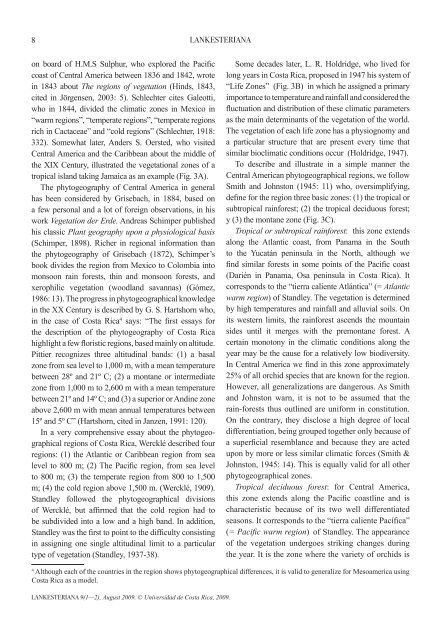orchids and orchidology in central america. 500 ... - lankesteriana.org
orchids and orchidology in central america. 500 ... - lankesteriana.org
orchids and orchidology in central america. 500 ... - lankesteriana.org
Create successful ePaper yourself
Turn your PDF publications into a flip-book with our unique Google optimized e-Paper software.
8<br />
on board of H.M.S Sulphur, who explored the Pacific<br />
coast of Central America between 1836 <strong>and</strong> 1842, wrote<br />
<strong>in</strong> 1843 about The regions of vegetation (H<strong>in</strong>ds, 1843,<br />
cited <strong>in</strong> Jörgensen, 2003: 5). Schlechter cites Galeotti,<br />
who <strong>in</strong> 1844, divided the climatic zones <strong>in</strong> Mexico <strong>in</strong><br />
“warm regions”, “temperate regions”, “temperate regions<br />
rich <strong>in</strong> Cactaceae” <strong>and</strong> “cold regions” (Schlechter, 1918:<br />
332). Somewhat later, Anders S. Oersted, who visited<br />
Central America <strong>and</strong> the Caribbean about the middle of<br />
the XIX Century, illustrated the vegetational zones of a<br />
tropical isl<strong>and</strong> tak<strong>in</strong>g Jamaica as an example (Fig. 3A).<br />
The phytogeography of Central America <strong>in</strong> general<br />
has been considered by Grisebach, <strong>in</strong> 1884, based on<br />
a few personal <strong>and</strong> a lot of foreign observations, <strong>in</strong> his<br />
work Vegetation der Erde. Andreas Schimper published<br />
his classic Plant geography upon a physiological basis<br />
(Schimper, 1898). Richer <strong>in</strong> regional <strong>in</strong>formation than<br />
the phytogeography of Grisebach (1872), Schimper’s<br />
book divides the region from Mexico to Colombia <strong>in</strong>to<br />
monsoon ra<strong>in</strong> forests, th<strong>in</strong> <strong>and</strong> monsoon forests, <strong>and</strong><br />
xerophilic vegetation (woodl<strong>and</strong> savannas) (Gómez,<br />
1986: 13). The progress <strong>in</strong> phytogeographical knowledge<br />
<strong>in</strong> the XX Century is described by G. S. Hartshorn who,<br />
<strong>in</strong> the case of Costa Rica 4 says: “The first essays for<br />
the description of the phytogeography of Costa Rica<br />
highlight a few floristic regions, based ma<strong>in</strong>ly on altitude.<br />
Pittier recognizes three altitud<strong>in</strong>al b<strong>and</strong>s: (1) a basal<br />
zone from sea level to 1,000 m, with a mean temperature<br />
between 28º <strong>and</strong> 21º C; (2) a montane or <strong>in</strong>termediate<br />
zone from 1,000 m to 2,600 m with a mean temperature<br />
between 21º <strong>and</strong> 14º C; <strong>and</strong> (3) a superior or And<strong>in</strong>e zone<br />
above 2,600 m with mean annual temperatures between<br />
15º <strong>and</strong> 5º C” (Hartshorn, cited <strong>in</strong> Janzen, 1991: 120).<br />
In a very comprehensive essay about the phytogeographical<br />
regions of Costa Rica, Wercklé described four<br />
regions: (1) the Atlantic or Caribbean region from sea<br />
level to 800 m; (2) The Pacific region, from sea level<br />
to 800 m; (3) the temperate region from 800 to 1,<strong>500</strong><br />
m; (4) the cold region above 1,<strong>500</strong> m. (Wercklé, 1909).<br />
St<strong>and</strong>ley followed the phytogeographical divisions<br />
of Wercklé, but affirmed that the cold region had to<br />
be subdivided <strong>in</strong>to a low <strong>and</strong> a high b<strong>and</strong>. In addition,<br />
St<strong>and</strong>ley was the first to po<strong>in</strong>t to the difficulty consist<strong>in</strong>g<br />
<strong>in</strong> assign<strong>in</strong>g one s<strong>in</strong>gle altitud<strong>in</strong>al limit to a particular<br />
type of vegetation (St<strong>and</strong>ley, 1937-38).<br />
LANKESTERIANA<br />
LANKESTERIANA 9(1—2), August 2009. © Universidad de Costa Rica, 2009.<br />
Some decades later, L. R. Holdridge, who lived for<br />
long years <strong>in</strong> Costa Rica, proposed <strong>in</strong> 1947 his system of<br />
“Life Zones” (Fig. 3B) <strong>in</strong> which he assigned a primary<br />
importance to temperature <strong>and</strong> ra<strong>in</strong>fall <strong>and</strong> considered the<br />
fluctuation <strong>and</strong> distribution of these climatic parameters<br />
as the ma<strong>in</strong> determ<strong>in</strong>ants of the vegetation of the world.<br />
The vegetation of each life zone has a physiognomy <strong>and</strong><br />
a particular structure that are present every time that<br />
similar bioclimatic conditions occur (Holdridge, 1947).<br />
To describe <strong>and</strong> illustrate <strong>in</strong> a simple manner the<br />
Central American phytogeographical regions, we follow<br />
Smith <strong>and</strong> Johnston (1945: 11) who, oversimplify<strong>in</strong>g,<br />
def<strong>in</strong>e for the region three basic zones: (1) the tropical or<br />
subtropical ra<strong>in</strong>forest; (2) the tropical deciduous forest;<br />
y (3) the montane zone (Fig. 3C).<br />
Tropical or subtropical ra<strong>in</strong>forest: this zone extends<br />
along the Atlantic coast, from Panama <strong>in</strong> the South<br />
to the Yucatán pen<strong>in</strong>sula <strong>in</strong> the North, although we<br />
f<strong>in</strong>d similar forests <strong>in</strong> some po<strong>in</strong>ts of the Pacific coast<br />
(Darién <strong>in</strong> Panama, Osa pen<strong>in</strong>sula <strong>in</strong> Costa Rica). It<br />
corresponds to the “tierra caliente Atlántica” (= Atlantic<br />
warm region) of St<strong>and</strong>ley. The vegetation is determ<strong>in</strong>ed<br />
by high temperatures <strong>and</strong> ra<strong>in</strong>fall <strong>and</strong> alluvial soils. On<br />
its western limits, the ra<strong>in</strong>forest ascends the mounta<strong>in</strong><br />
sides until it merges with the premontane forest. A<br />
certa<strong>in</strong> monotony <strong>in</strong> the climatic conditions along the<br />
year may be the cause for a relatively low biodiversity.<br />
In Central America we f<strong>in</strong>d <strong>in</strong> this zone approximately<br />
25% of all orchid species that are known for the region.<br />
However, all generalizations are dangerous. As Smith<br />
<strong>and</strong> Johnston warn, it is not to be assumed that the<br />
ra<strong>in</strong>-forests thus outl<strong>in</strong>ed are uniform <strong>in</strong> constitution.<br />
On the contrary, they disclose a high degree of local<br />
differentiation, be<strong>in</strong>g grouped together only because of<br />
a superficial resemblance <strong>and</strong> because they are acted<br />
upon by more or less similar climatic forces (Smith &<br />
Johnston, 1945: 14). This is equally valid for all other<br />
phytogeographical zones.<br />
Tropical deciduous forest: for Central America,<br />
this zone extends along the Pacific coastl<strong>in</strong>e <strong>and</strong> is<br />
characteristic because of its two well differentiated<br />
seasons. It corresponds to the “tierra caliente Pacífica”<br />
(= Pacific warm region) of St<strong>and</strong>ley. The appearance<br />
of the vegetation undergoes strik<strong>in</strong>g changes dur<strong>in</strong>g<br />
the year. It is the zone where the variety of <strong>orchids</strong> is<br />
4 Although each of the countries <strong>in</strong> the region shows phytogeographical differences, it is valid to generalize for Meso<strong>america</strong> us<strong>in</strong>g<br />
Costa Rica as a model.
















